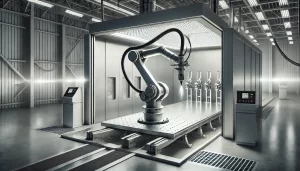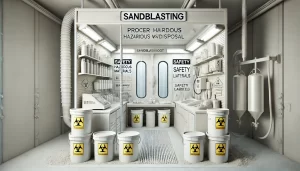Sandblasting, also known as abrasive blasting, is a highly effective method for cleaning, smoothing, or shaping surfaces. It’s widely used in industries like automotive repair, construction, and manufacturing to remove paint, rust, or other surface contaminants. The process works by propelling abrasive materials under high pressure to impact the surface being treated. However, the success of sandblasting relies heavily on the type of abrasive material used. Choosing the right material can make a significant difference in achieving the desired results while also considering cost, environmental impact, and safety.
Traditional Sand
Sand is the original abrasive material for sandblasting, and it’s where the process gets its name. It is still used in certain applications due to its availability and effectiveness on tough surfaces. Sand is typically employed for removing rust or old paint from metal surfaces, as well as etching designs into glass.
However, the use of sand has diminished over time due to its potential health hazards. When traditional sand is blasted, it produces fine silica dust, which can lead to a serious respiratory condition called silicosis if proper protective measures aren’t taken. In many regions, stricter regulations have limited or even banned the use of sand in sandblasting.
Aluminum Oxide
Aluminum oxide is one of the most versatile and widely used materials in sandblasting. It is hard, durable, and capable of cutting through tough coatings like paint, rust, or scale with ease. This abrasive is often chosen for applications where precision and surface preparation are key, such as preparing metals for coating or welding.
One of the standout qualities of aluminum oxide is its reusability. It can be collected and recycled multiple times without losing effectiveness, making it an economical and eco-friendly choice. Additionally, it produces minimal dust, reducing the risk of respiratory issues and maintaining a cleaner work environment.
Glass Beads
Glass beads are an excellent option for achieving a smoother, more polished finish. These tiny spheres are made from soda-lime glass and are commonly used in applications that require gentle cleaning or finishing, such as restoring delicate automotive parts or removing surface contaminants from stainless steel.
Unlike harsher abrasives, glass beads do not damage the underlying material, making them ideal for preserving the structural integrity of softer surfaces. They also create a uniform, satin-like texture, which is highly desirable in industries like aerospace and medical equipment manufacturing.
Steel Grit and Steel Shot
Steel abrasives, including steel grit and steel shot, are popular in industrial sandblasting for their toughness and efficiency. Steel grit, with its angular shape, is perfect for aggressive cleaning tasks like removing heavy rust or old coatings. It is often used in shipbuilding, bridge construction, and other heavy-duty applications.
On the other hand, steel shot has a round shape, making it less abrasive but highly effective for peening, a process that strengthens metal surfaces. Steel abrasives are known for their durability and reusability, which reduces overall costs in large-scale projects.
Silicon Carbide
For the most demanding jobs, silicon carbide is often the material of choice. Known for its extreme hardness, it can tackle even the toughest surfaces and is capable of cutting through ceramics, stone, and other hard materials with ease. Silicon carbide is also suitable for engraving glass or etching designs into harder materials.
While silicon carbide is highly effective, its cost can be a limiting factor for some applications. However, for industries where precision and durability are critical, this abrasive is worth the investment.
Plastic Abrasives
Plastic abrasives are a more recent addition to the sandblasting world and have become increasingly popular for their versatility and eco-friendliness. Made from materials like polyester or acrylic, these abrasives are lightweight and gentle, making them suitable for cleaning sensitive surfaces such as aluminum, fiberglass, and even wood.
Plastic abrasives are particularly useful in applications like aircraft maintenance or automotive restoration, where preserving the substrate’s integrity is crucial. They are also biodegradable, which appeals to businesses seeking environmentally responsible solutions.
Walnut Shells
Walnut shells are a natural, biodegradable abrasive that offers a softer approach to sandblasting. This organic material is commonly used in applications like cleaning engines, removing graffiti, or polishing softer surfaces. Walnut shells do not generate heat during the blasting process, making them ideal for materials that are sensitive to warping or heat damage.
As a renewable resource, walnut shells are an excellent choice for industries looking to reduce their environmental footprint. They are also less hazardous to workers compared to more abrasive materials, which adds to their appeal.
Corn Cob
Another eco-friendly option is corn cob, which is similar to walnut shells in terms of softness and sustainability. It is often used to clean wooden surfaces, delicate equipment, or machinery without causing damage. Corn cob abrasives are ideal for removing grime, grease, or coatings from surfaces without altering the base material’s structure.
Corn cob is lightweight and produces minimal dust, making it a safe and efficient option for sensitive projects.
Garnet
Garnet is a natural mineral abrasive known for its hardness and durability. It is highly effective for cutting through tough materials while producing very little dust. Garnet is particularly valued in industries like shipbuilding, where a clean and precise surface preparation is necessary for painting or coating.
Unlike some other abrasives, garnet is non-toxic and free of heavy metals, making it safer for workers and the environment. It is also reusable, further enhancing its appeal for large-scale or ongoing projects.
Staurolite
Staurolite is a mineral abrasive that strikes a balance between performance and affordability. It is often used for removing coatings, rust, or mill scale from steel surfaces. Staurolite is less abrasive than materials like aluminum oxide or silicon carbide, making it a cost-effective choice for general-purpose sandblasting.
Additionally, staurolite has a low silica content, which reduces the health risks associated with inhaling silica dust. This makes it a safer option for both workers and the surrounding environment.
Choosing the Right Abrasive
Selecting the right abrasive material for sandblasting depends on several factors, including the type of surface being treated, the desired finish, and the project’s budget. For heavy-duty cleaning or surface preparation, materials like aluminum oxide, steel grit, or silicon carbide are ideal. If you’re working with delicate surfaces, consider glass beads, plastic abrasives, walnut shells, or corn cob.
Cost and environmental impact also play a significant role. Reusable abrasives like aluminum oxide or garnet are more economical in the long run, while biodegradable options like walnut shells or corn cob are great for eco-conscious projects.
Specialized Sandblasting Booth Services
We specialize in providing top-quality sandblasting booths and custom finishing solutions tailored to meet the unique needs of various industries. Our expert team designs and manufactures state-of-the-art sandblasting booths that ensure safety, efficiency, and superior performance. From automotive and aerospace to marine and industrial applications, our booths are engineered to handle even the most demanding surface preparation tasks. We offer comprehensive services, including booth installation, maintenance, upgrades, and technical support.




